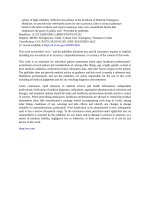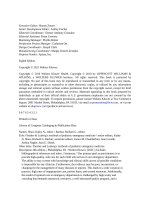Pediatric emergency medicine trisk 3086 3086
Bạn đang xem bản rút gọn của tài liệu. Xem và tải ngay bản đầy đủ của tài liệu tại đây (70.88 KB, 1 trang )
amino acid metabolism. Inhibition of Krebs cycle enzymes and uncoupling of
oxidative phosphorylation in conjunction with lipid disturbances create the
combined lactic and ketoacidosis responsible for metabolic acidosis (which leads
to the mixed respiratory alkalosis and metabolic acidosis found on the arterial
blood gas). Volume losses caused by vomiting, tachypnea, and diaphoresis can
lead to significant volume depletion. In addition to inhibiting platelet function,
aspirin intoxication is associated with disturbances in vitamin K–dependent and
vitamin K–independent clotting factors, resulting in a significant coagulopathy.
Mild elevations in liver enzymes are also common. Other features of aspirin
intoxication include leukocytosis and electrolyte disturbances, particularly
hypokalemia.
Clinical Considerations
Physical manifestations of salicylism include fever, tachypnea, nausea, vomiting,
lethargy, slurred speech, and seizures. Children with chronic salicylism are more
likely to present with severe metabolic acidosis and seizures than those with acute
intoxication.
The combination of respiratory alkalosis with metabolic acidosis produces an
arterial blood gas that is almost pathognomonic for salicylism. Serum pH
typically ranges from 7.41 to 7.55, except in severe cases in which metabolic
acidosis combined with respiratory acidosis from severe CNS depression leads to
pH less than 7.35, and PCO 2 is generally less than 30 mm Hg. Serum bicarbonate
is mildly depressed, often ranging from 15 to 20 mEq/L. Although adults may
continue to hyperventilate for extended periods when poisoned with salicylates,
children with mild to moderate poisoning quickly lose this respiratory drive and
are more likely to present with metabolic and respiratory acidosis.
Glucose homeostasis is seriously altered in acute aspirin poisoning. Early in the
course, hyperglycemia usually occurs because of glycogenolysis and decreased
peripheral use. Later, hypoglycemia may supervene as glucose stores are
depleted. High rates of oxidative metabolism in the CNS may lead to low CNS
glucose concentration even in the presence of peripheral hyperglycemia.
Fluid and electrolyte disturbances are multifactorial, resulting in dehydration,
hyponatremia or hypernatremia, and hypokalemia. Among contributing factors
are increased insensible water losses through both skin and lungs, emesis, and
increased renal water and potassium loss. The patient with severe salicylate
poisoning may lose 4 to 6 L of water per square meter.
The initial clinical signs and symptoms, the estimate of dose ingested, and the
measurement of salicylate levels all serve to gauge the severity of a given acute









